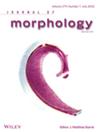Comparative Osteology of the Hynobiid Complex Liua-Protohynobius-Pseudohynobius (Amphibia, Urodela): II. Anatomy and Taxonomic Revision of Enigmatic Protohynobius puxiongensis
Abstract
An enigmatic salamander species Protohynobius puxiongensis was named 25 years ago but since then has been disputed as a genus and species of its own or a species in the genus Pseudohynobius. Here, we provide a detailed anatomical account for P. puxiongensis based on micro-CT scans of five specimens, including one larva, one subadult and three adults. For the first time we reveal anatomical details in the braincase, hyobranchium and the postcranial skeleton. Our comparative study with species of Pseudohynobius and Liua clarified previous disputes over the anatomy of the skull, and confirmed that the internasal bone is an intraspecific variation that is present in several hynobiid species. Our study found that P. puxiongensis possesses fundamental morphological features that distinguish this enigmatic salamander from all species in the genus Pseudohynobius; therefore, the results of our study provide evidence to reject the combination of “Pseudohynobius puxiongensis”, and support Protohynobius as the valid generic name for the species in question for the purpose of the Principle of Priority. The extensive morphological disparities between Protohynobius and Pseudohynobius identified herein combined with their relatively short genetic distances recognized by previous studies indicate that these hynobiids have had a high evolutionary rate that may be associated with the intense orogenies around the eastern edge of the Qinghai-Tibetan Plateau during the Neogene.


 求助内容:
求助内容: 应助结果提醒方式:
应助结果提醒方式:


